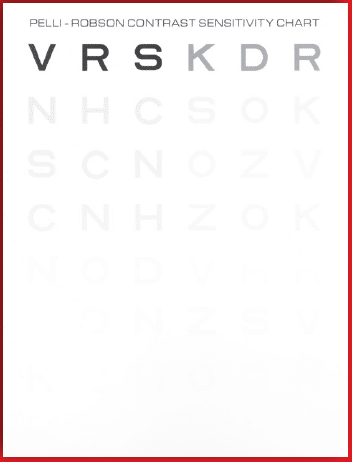
EyeOnVision June, 2021 – New Low Contrast Test!
A CLOSER LOOK
New Product!
Mayer-Kran™ Double-Happy™
Low Contrast Test

The Mayer-Kran™ Double-Happy™ Low Contrast Test is intended for children and older individuals who are unable to name or match letters, that is, individuals who cannot be tested with standard letter contrast tests. The test cards are printed with a smiling schematic face offset from the center of the card; the face is identical when the card is rotated 180 deg.
BEHIND THE TEST

Precision Vision is humbled and honored to partner with Dr. D. Luisa Mayer, Associate Professor, and Dr. Barry S. Kran, Professor, of the New England College of Optometry. With this honor, we are able to provide the world the Mayer-Kran™ Double-Happy™ Contrast Test.
“Behind The Test” is including a brief Question & Answer from the developer’s perspective.
1. Where did the idea for this test originate?
As clinicians, we realized that young patients had difficulties seeing low contrast objects yet there was no reliable, validated test appropriate for them.
2. Why did you take on this work?
To provide a quick and useful test of contrast sensitivity (CS) for a diverse pediatric population and older patients as well.
3. What was your development timeline?
We started researching this test years ago with students from the New England College of Optometry, our parent institution. Learning from those studies, we thought the test was ready for research with young patients (which was started in approximately 2014).
4. Any interesting stories or lessons learned during the development?
As we were developing the test, we had patients with relatively good acuity and grossly full visual fields yet their function was more like someone with significant visual impairment. Some of these patients were found to have quite poor contrast with our test. As a result, appropriate compensatory strategies could be employed to improve access the environment, learning and for activities of daily living.
5. Who is the targeted demographic (Doctor & Patient Group) this test was developed for?
Individuals who cannot perform letter contrast tests, such as the Pelli Robson and Mars tests. These individuals include young children, those with significant intellectual disability, and older persons who have lost the ability to read letters.
6. What makes this test unique to the eye care industry?
- The simple face stimulus (Double-Happy).
- A test design and method that is the same as the Teller Acuity Cards©*
- Two test formats: Full set (for assessing threshold) and a Screening set, with detailed instructions for each set, and guidelines for interpreting the test results.
7. Are there specific eye abnormalities or diseases this test will diagnose or predict?
This test will not diagnose any disease but it will provide a behavioral measure of contrast. Some of the conditions associated with reduced contrast include cerebral visual impairment as well as certain ocular diseases and developmental delay
8. What is your favorite feature of this test?
- The test can be administered objectively, without the examiner being aware of the position of the Double Happy face.
- The horizontal dimension of the card is equal to the test distance.
*Teller Acuity Cards® is a U.S. registered trademark of the University of Washington and used under license.
ASK PRECISION VISION

Q: Is there existing research on Mayer-Kran™ Double-Happy™ Low Contrast Test?
A: Dr. Mayer & Dr. Kran published a study of test-retest reliability of this test in pediatric patients. This research provides an index of significant change in CS between testers or between visits. Our results also showed that CS in patients diagnosed with CVI was reduced compared to patients with ocular disorders. This publication is referenced and linked below.






